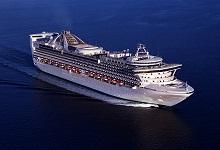Recently Viewed Cruises
- Star, Inside Passage with Glacier Bay ex Seattle ReturnAdd to favourites
- Millennium, Southbound Alaska ex Seward to VancouverAdd to favourites
- Safari Quest, Wilderness Passages of Discovery ex Seattle to JuneauAdd to favourites
- Volendam, Alaska ex Skagway to VancouverAdd to favourites
- Wilderness Adventurer, Inner Reaches Western Coves ex Ketchikan to JuneauAdd to favourites
- Royal Caribbean International raises the bar
- Classy Astor fills gap in market
- Oceanic Discoverer
- Ab Fab Oosterdam
- Catch up on Cruising: Latest cruise news in bite size
- Frequently Asked Questions
-
Star, Inside Passage with Glacier Bay ex Seattle Return
Nights 7 Ship Star Princess Star Rating 
Departs Seattle, Washington, USA Sailing 2013: 11 May ,25 May ,8 Jun ,22 Jun ,6 Jul ,20 Jul ,3 Aug ,17 Aug ,31 Aug ,14 Sep Ports of Call Seattle, Juneau, Skagway, Glacier Bay, Ketchikan, Victoria Please enquire about this cruise for pricing.
7 Night Cruise sailing from Seattle roundtrip aboard Star Princess.
Star Princess's impressive design and amenities include an entire deck of mini-suites, four different pools spread out over three decks and enough after-dinner options and showlounges to keep you entertained for weeks on end. The revolutionary ship design offers all the big ships choices, but you will never feel lost in a crowd.
Highlights of this cruise:
Seattle, Washington
Seattle is a young city with a rich history. Settlers first landed at Alki Point in 1851 and named the area after Sealth, the Suquamish Indian chief who befriended them. Rebuilt after the Great Fire of 1889, "The Emerald City" has a legacy of vision and strength. Seattle has hosted two World's Fairs (1909 and 1962) and is the birthplace of two modern marvels, Boeing and Microsoft.
Known for its rainy climate, Seattle actually averages less annual rainfall than many East Coast cities. The mild weather, spectacular natural surroundings and rich cultural diversity attract visitors from around the world.
Juneau, Alaska
In 1880, it was slow going for Joe Juneau and Richard Harris as they searched for gold with the help of Native guides. After climbing mountains, forging streams and facing countless difficulties, they found nuggets "as large as beans."
From their discovery came three of the largest gold mines in the world. By the end of World War II, more than $150 million in gold had been mined. Eventually the mines closed, but the town Joe Juneau founded became the capital
of Alaska and the business of gold was replaced by the business of government.
Some 30,000 people live in Juneau. Its total area makes it one of the biggest towns, in size, in the world. Only Kiruna, Sweden, and Sitka, Alaska, exceed Juneau's 3,248 square miles.
Today Juneau is famous not only for gold and government but also for its breathtakingly beautiful glaciers and stunning views of both water and mountains.
Skagway, Alaska
Skagway was the gateway to the gold fields for the thousands who flocked to Alaska and the Yukon with the hope of striking it rich. Skagway may have boasted the shortest route to the Klondike, but it wasn't the easiest.
Over 100 years ago, the White Pass route through the Coast Mountains and the shorter but steeper Chilkoot Trail were used by countless stampeders. Many a would-be miner perished on the treacherous Chilkoot Trail.
The gold rush was a boon and by 1898, Skagway was Alaska's largest town with a population of about 20,000. Hotels, saloons, dance halls and gambling houses prospered. But when the gold yield dwindled in 1900, so did the population as miners quickly shifted to new finds in Nome.
Today, Skagway has less than 1,000 residents. It still retains the flavor of the gold rush era.
Ketchikan, Alaska
Ketchikan is known as Alaska's "First City" because it's the first major community travelers come to as they journey north. Located on an island, Ketchikan began life as an Indian fishing camp. The name Ketchikan comes from a Tlingit phrase that means "eagle with spread-out wings," a reference to a waterfall near town.
In the early 1900s, when gold was Alaska's claim to fame, fishing and timber industries were established in Ketchikan. The growth of these industries helped make this Inside Passage port Alaska's fourth-largest city.
Visitors to Ketchikan will be intrigued by its rich Native heritage, which includes the world's oldest collection of totem poles at Totem Heritage Center. The Haida, Tlingit and Tsimshian are all a part of the city's colorful history. Ketchikan, with its abundance of salmon, is also a sportfishing paradise. Sightseers will be impressed with both the scenic town and its surroundings, especially Misty Fjords National Monument.
Victoria, British Columbia
Victoria exudes old-world charm and fragrant and colorful flowers are everywhere. Founded in 1843 by James Douglas of the Hudson's Bay Company, the city was first known as Fort Victoria. By 1848, Vancouver Island was a British colony and Victoria was its capital.
In 1858, Victoria was a tent city and the base for some 25,000 prospectors on their way to the Frasier River gold fields. When Vancouver Island was incorporated with mainland British Columbia in 1868, Victoria became the capital of the entire province.
Although it's a port city, Victoria is not as industrially oriented as Vancouver. The harbors, especially Inner Harbour, are dotted with pleasure craft, ferries and floatplanes. The city is renowned for its beautiful gardens, charming houses and very British feel.







